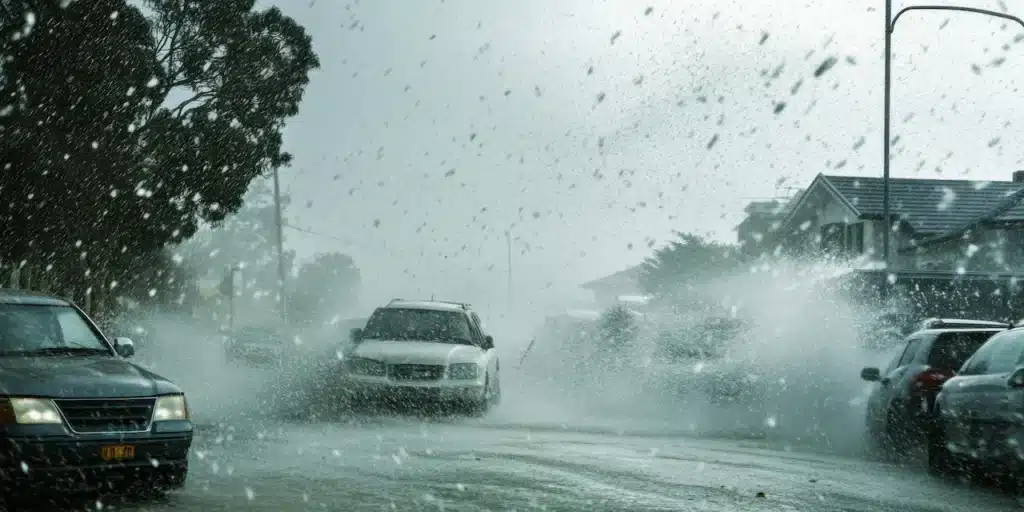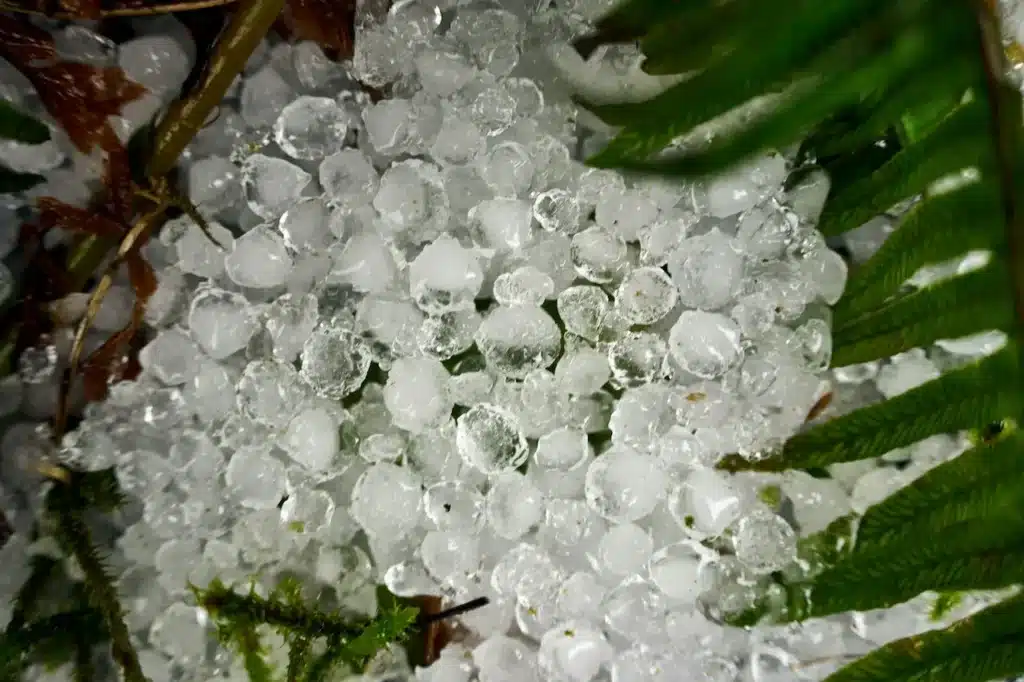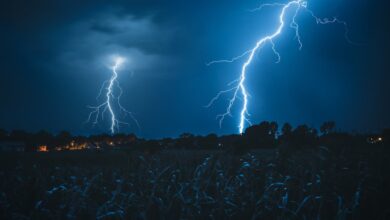Understanding How Hailstones Form
Hailstones, which are composed of layers of ice, form in the strong updrafts that accompany thunderstorms. These air currents act like elevators to carry water droplets into the towering clouds of storms. Even in summer, temperatures can be extremely low inside these storm systems.
How hailstones form? Water vapour is condensed into small droplets by the wind. These droplets encounter temperatures below freezing as they are blown higher in the storm. They can then become supercooled, meaning they remain liquid even though the temperature has fallen below 0 degrees Celsius. They are highly unstable in this state and can freeze instantly when they come into contact with solid surfaces. A supercooled droplet freezes instantly when it collides with an airborne particle such as dust or pollen.
The hail embryos rise and fall in the “hail growth zones” of storms, a turbulent area where temperatures can range between -10 °C and to -25 °C. They are constantly being bombarded by supercooled water drops as they ascend in the strong updraft. These droplets freeze immediately when they contact the embryo. They form new layers of ice surrounding the original core. Every trip through the cloud creates another layer. This can result in hailstones that have an onion-like appearance when cut.

The updraught strength is a key factor in determining the size of a hailstone. Updrafts in powerful storms can reach speeds of up to 160 km/h. This allows hailstones to remain aloft for long enough to reach the size and shape of a golf ball, tennis ball, or grapefruit. Gravity eventually wins. The hailstone will fall to the ground when it becomes too heavy to be supported by the updraught, or if the updraught is weakening. This can often be accompanied by damaging winds and torrential rainfall.
Some hailstones may merge or break during their turbulent travels, resulting in irregular shapes or clusters of ice. Scientists who study hailstones often discover that the layers of the hailstone act as a record of the hailstone’s growth. It shows how many times it has been through the updraft of the storm and how different the conditions were at various heights.
How does hail form?
Strong updrafts in thunderstorms carry water droplets into the air, where they freeze into ice. These ice crystals can be carried by the wind and then collide with supercooled water drops, which grow in size.
The larger the hailstone, the stronger the updraft of a storm. The hailstones become heavier and larger, and gravity takes over. As a result, the updraft of the storm can no longer hold the weight.
The size of hailstones depends on the updrafts and how long the hailstones stay in the cloud to grow. Supercell thunderstorms produce the biggest hail because of their strong updrafts.
As the updraft carries the hailstones up and down the cloud, they can sometimes form multiple layers of ice. When a hailstone, which is carried by the rising air of a storm, or the updraft and then thrown into the atmosphere, above the freezing level, refreezes, it grows. This can lead to large hail, particularly if it occurs repeatedly.
Hailstones as large as softballs or grapefruits can cause damage to vehicles, buildings, and crops. The hailstone in Vivian, S.D., currently holds the Record as the largest hailstone in the U.S. with a diameter of 18.62 inches and weighing 1 pound 15 ounces. This hailstone was created by a severe storm on July 23, 2010.
Is climate change causing hailstorms?
Many people wonder if the increasing reports of hail damage around the world are related to climate change. Like much of climate science, the answer is complex. However, evidence indicates that climate change influences conditions that produce large hail.

Scientists have studied four decades’ worth of data on hailstorms to better understand their patterns. In a major study, scientists found that the conditions for large hailstones – those larger than golf balls – have become more common in the eastern and central United States. The trend is a result of the warmer, wetter air masses, which provide storms with the energy they need to produce powerful updrafts. The northern Plains did not show a clear increase in the number of large hailstones based on radar observations or formation factors. This indicates that, while some areas are experiencing larger hail events than others, they may not all be the same.
Climate change can contribute to increased hailstorm intensity in two primary ways:
-
Heat and humidity increase. As the Earth heats up, the air becomes more moist, warm, and warm. This energy drives stronger thunderstorms, and the abundance of supercooled water at the top of the storm clouds gives more material to grow hailstones.
-
Shifts of unstable air masses. In North America, unstable air masses, which previously accumulated over the high west terrain, are now moving more eastward. Snowpacks are melting earlier than usual in mountainous regions. Less snow on the ground allows the earth to absorb heat more quickly, like turning on a hot stove. This causes warm air to rise earlier in the year and causes instability.
The distribution of the size of hailstones may be affected by climate change. As global warming increases the freezing level of the atmosphere, smaller hailstones will melt before they reach the ground. However, larger hailstones that fall faster and are heavier may survive the descent. We could expect fewer smaller hailstones but more damaging large hailstones.
Combining warmer temperatures, stronger storms and higher freezing levels, “giant hail” events could become more frequent in certain areas. It has implications for communities preparing for extreme weather, including property insurance and infrastructure planning.

Where and when are hailstorms most likely to occur in Australia?
In Australia, hailstorms can occur at any time. However, the most damaging and severe hail occurs during the spring and early summer. (September to December). The peak of Australia’s storm season is during this period, particularly in the east and southeast parts of the nation. In spring, as the continent begins to warm, the surface temperature rises rapidly, creating unstable atmospheric conditions that are necessary for thunderstorms. The upper atmosphere is relatively cool following winter. This allows for large temperature contrasts, which are essential for the formation of hail.
In contrast, winter showers and thunderstorms are usually less energetic and do not have the same vertical motion as their summer and spring counterparts. In the cooler months, updrafts are weaker, and so hail tends to form smaller.
The following regions are prone to hail in Australia:
-
Southeastern Queensland and northeastern New South Wales – This region is known as Australia’s “hail Alley” and has some of the biggest and most frequent hailstorms in the country. Spring storms are especially dangerous for cities like Brisbane and Sydney.
-
Victoria – Severe hailstorms can occur, but are not as frequent. They are often associated with the cold fronts that sweep across southern Australia during spring and autumn.
-
Western Australia– Storms near the coast can cause severe hail in spring and early summer.
-
Tropical north Australia. While hail is more common in the tropics than elsewhere, severe storms that produce large hailstones can occur during the lead-up to the wet season.
In Australia, hail events have caused some of the most costly natural disasters. Sydney’s hailstorm in April 1999, for example, caused billions of dollars in damage with hailstones as large as 9 cm (the same size as cricket balls). In Canberra, hailstones as large as golf balls fell on the city in the January 2020 hailstorm. This caused tens and thousands of cars and buildings to be damaged.
How to be safe during a hailstorm
It can be terrifying to find yourself in the middle of a storm with large hail. If you find yourself in a similar situation, here are safety tips:
- If you’re driving, pull over safely. Stay in your vehicle. Drive to an awning at a gas station or garage where you can find shelter.
- When you are outside, find a solid shelter like a building. Protect your head if you are caught in the open.
- Stay inside if you are inside and away from the windows until the hail stops.
Taking a few steps now will help you avoid future headaches. Understand what is covered by your car and homeowners’ insurance. Beware of scams involving roof replacements by people who claim to have experienced a hailstorm. Preventive thinking is also important by selecting building materials to your homes that are more resistant to hail damage.




